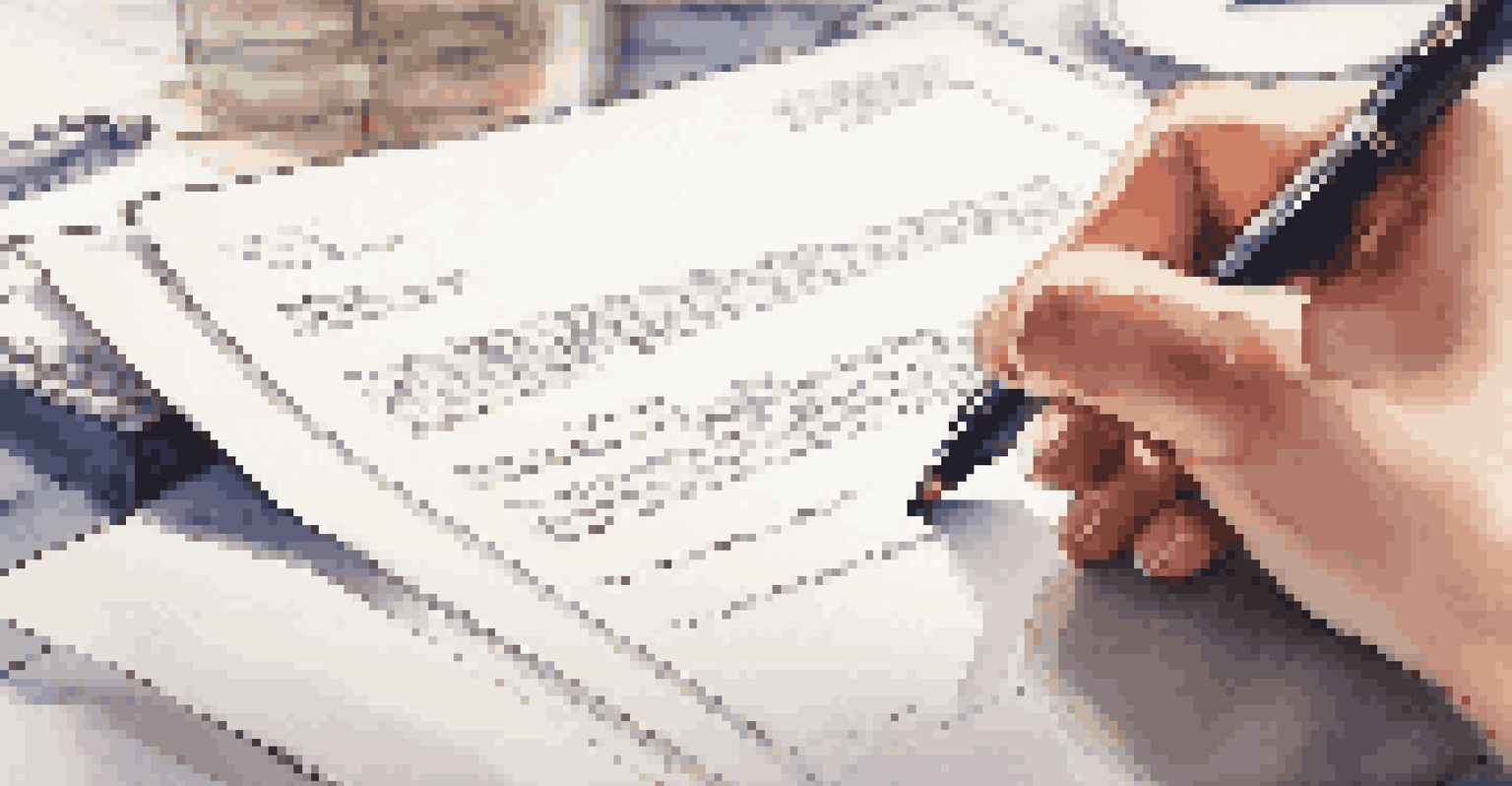Tips for Writing an Effective Cover Letter with Your Resume

Understand the Purpose of a Cover Letter
A cover letter serves as your personal introduction to a potential employer, complementing your resume. It allows you to explain why you’re a great fit for the position, highlighting specific experiences and skills. Think of it as your chance to showcase your personality and enthusiasm, which can sometimes get lost in a resume's bullet points.
A cover letter is a way to express your personality and enthusiasm, which can sometimes get lost in a resume's bullet points.
By tailoring your cover letter to each job application, you demonstrate genuine interest in the role and the company. This personal touch can set you apart in a sea of applications, making it clear that you’ve done your homework. Remember, a well-crafted cover letter can grab the hiring manager's attention right from the start.
Overall, the cover letter gives you the opportunity to connect the dots between your experiences and the job requirements, making it a crucial part of your application package. So, embrace this opportunity to speak directly to the hiring team!
Tailor Your Cover Letter to the Job Description
One of the most effective strategies for writing a cover letter is customizing it for each job you apply for. This means analyzing the job description and mirroring the language and skills mentioned within it. When you align your qualifications with the company’s needs, it shows that you’re attentive and genuinely interested.

For example, if the job description emphasizes teamwork, share a brief story about a successful project you led with a team. This not only illustrates your skills but also provides a narrative that the hiring manager can remember. Tailoring your letter helps create a strong connection between your experiences and the job requirements.
Purpose of a Cover Letter
A cover letter introduces you to potential employers, allowing you to showcase your personality and fit for the role.
Incorporating keywords from the job posting also aids in optimizing your cover letter for applicant tracking systems (ATS). This increases the chances that your application will be seen by a human reader, enhancing your visibility in the hiring process.
Use a Professional Format and Structure
The format of your cover letter is just as important as its content. Start with a professional header that includes your name, contact information, and the date, followed by the employer’s contact details. This structured approach not only looks polished but also makes it easy for hiring managers to find your information.
The best way to predict the future is to create it.
Next, divide your letter into distinct sections: an introduction, body paragraphs, and a closing statement. Each section should flow logically, with clear transitions between ideas. This organization helps maintain the reader’s attention and makes your main points stand out.
Lastly, keep your cover letter to one page, as brevity is key. A concise, well-organized letter shows respect for the reader's time while effectively communicating your qualifications and enthusiasm for the role.
Craft a Compelling Opening Statement
Your opening statement is your chance to make a strong first impression, so make it count! Start with a hook that grabs attention—consider mentioning a mutual connection or a notable achievement that relates to the job. This personal touch can create an instant connection with the reader.
For instance, instead of saying, 'I am applying for the marketing position,' you might say, 'As a passionate marketer with over five years of experience in digital campaigns, I was thrilled to see your opening for a marketing manager.' This approach sets a positive tone and showcases your enthusiasm right off the bat.
Customize for Each Job
Tailoring your cover letter to the job description demonstrates genuine interest and enhances your chances of making a memorable impression.
A compelling opening not only entices the hiring manager to read further but also establishes your unique value proposition. Remember, you want them to feel eager to learn more about you and how you can contribute to their team.
Highlight Relevant Skills and Experiences
When it comes to writing a cover letter, specificity is key. Instead of listing generic skills, focus on those that are most relevant to the job. Use concrete examples to illustrate your achievements, such as 'I increased sales by 20% within six months'—this adds credibility and makes your application memorable.
Moreover, storytelling can be a powerful tool in this section. Share a brief anecdote about a challenge you faced and how you overcame it, showcasing not just your skills but also your problem-solving abilities and resilience. This narrative approach helps paint a vivid picture of your capabilities.
Remember, the goal is to create a compelling case for why you are the right fit for the job. By highlighting relevant skills and experiences, you provide the hiring manager with clear evidence of your qualifications and how you can add value to their team.
Conclude with a Strong Closing Statement
The conclusion of your cover letter is your final opportunity to leave a lasting impression. Reiterate your enthusiasm for the position and briefly summarize why you would be a great fit for the role. This reinforces your interest and keeps you top of mind.
Additionally, express your eagerness to discuss your application further. A statement like 'I look forward to the opportunity to discuss how my skills can contribute to your team' shows confidence and readiness for the next steps in the hiring process.
Proofread for Professionalism
Thorough proofreading ensures your cover letter is free of errors, reflecting attention to detail and professionalism in your application.
Finally, don’t forget to thank the reader for their time and consideration. A polite and gracious closing sentiment can make your application feel more personal and sincere, enhancing your overall impression.
Proofread and Edit Your Cover Letter
Before sending out your cover letter, take the time to proofread and edit it thoroughly. Spelling mistakes or grammatical errors can create a negative impression and suggest a lack of attention to detail. A simple read-through can help you catch these small but significant mistakes.
Consider reading your letter aloud or asking a friend to review it. Sometimes, a fresh pair of eyes can spot issues you might have missed and offer valuable feedback. This step is crucial in ensuring you present your best self.

Additionally, check for clarity and conciseness. Every word should serve a purpose, so remove any fluff or repetitive phrases. A polished cover letter not only reflects your professionalism but also strengthens your overall application.